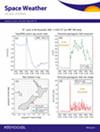Refined Modeling of Geoeffective Fast Halo CMEs During Solar Cycle 24
IF 3.7
2区 地球科学
引用次数: 0
Abstract
The propagation of geoeffective fast halo coronal mass ejections (CMEs) from solar cycle 24 has been investigated using the European Heliospheric Forecasting Information Asset (EUHFORIA), ENLIL, Drag-Based Model (DBM) and Effective Acceleration Model (EAM) models. For an objective comparison, a unified set of a small sample of CME events with similar characteristics has been selected. The same CME kinematic parameters have been used as input in the propagation models to compare their predicted arrival times and the speed of the interplanetary (IP) shocks associated with the CMEs. The performance assessment has been based on the application of an identical set of metrics. First, the modeling of the events has been done with default input concerning the background solar wind, as would be used in operations. The obtained CME arrival forecast deviates from the observations at L1, with a general underestimation of the arrival time and overestimation of the impact speed (mean absolute error [MAE]: 9.8 ± 1.8–14.6 ± 2.3 hr and 178 ± 22–376 ± 54 km/s). To address this discrepancy, we refine the models by simple changes of the density ratio (dcld) between the CME and IP space in the numerical, and the IP drag (γ) in the analytical models. This approach resulted in a reduced MAE in the forecast for the arrival time of 8.6 ± 2.2–13.5 ± 2.2 hr and the impact speed of 51 ± 6–243 ± 45 km/s. In addition, we performed multi-CME runs to simulate potential interactions. This leads, to even larger uncertainties in the forecast. Based on this study we suggest simple adjustments in the operational settings for improving the forecast of fast halo CMEs.太阳周期 24 期间地球效应快速晕 CME 的精细建模
利用欧洲日光层预报信息资产(EUHFORIA)、ENLIL、基于阻力的模型(DBM)和有效加速度模型(EAM)对太阳周期24产生的地球效应快速日晕日冕物质抛射(CMEs)的传播进行了研究。为了进行客观比较,选择了具有类似特征的小样本 CME 事件的统一集合。相同的 CME 运动参数被用作传播模型的输入,以比较它们的预测到达时间和与 CME 相关的行星际(IP)冲击速度。性能评估基于一套相同的指标。首先,对事件建模时使用了有关背景太阳风的默认输入,就像在运行中使用的那样。得到的 CME 到达预报与 L1 的观测结果有偏差,一般低估了到达时间,高估了撞击速度(平均绝对误差 [MAE]:9.8 ± 1.8-14.6 ± 2.3 小时和 178 ± 22-376 ± 54 公里/秒)。为了解决这一差异,我们通过简单改变数值模型中 CME 和 IP 空间的密度比 (dcld) 以及分析模型中 IP 阻力 (γ)来完善模型。这种方法降低了到达时间(8.6 ± 2.2-13.5 ± 2.2 小时)和撞击速度(51 ± 6-243 ± 45 公里/秒)的预报最大误差。此外,我们还进行了多CME运行,以模拟潜在的相互作用。这导致了预测中更大的不确定性。在这项研究的基础上,我们建议对运行设置进行简单调整,以改进对快速光环 CME 的预报。
本文章由计算机程序翻译,如有差异,请以英文原文为准。
求助全文
约1分钟内获得全文
求助全文

 求助内容:
求助内容: 应助结果提醒方式:
应助结果提醒方式:


